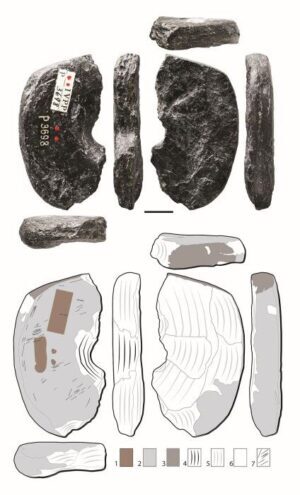
CNRS—Our ancestors were already living in the north of present-day China around 45,000 years ago. This discovery, made as a result of research at the Shiyu site by an international team including researchers from CNRS1 , challenges the established timeline of colonization in China by Homo sapiens populations 40,000 years ago.
Located about 20 kilometers from the city of Shuozhou, the Shiyu site is, to date, the oldest archaeological site with evidence of the arrival of modern humans in China. Artifacts discovered, including a perforated disc made of graphite — currently the oldest jewelry item ever found in China — and a bifacially shaped bone tool, present a series of characteristics indicative of a diverse range of cultural influences at the time our species arrived in the region. Analysis of tools made of obsidian, a volcanic rock, also revealed the existence of social networks spread over distances of up to 1,000 kilometers. Scientists believe that interactions between Homo sapiens and indigenous populations, far more complex than archaeologists previously imagined, led to significant genetic and cultural mixing.
These results, published on 18 January in Nature Ecology & Evolution,* shed new light on the global expansion of Homo sapiens and broaden our understanding of human history.
____________________________

Fragment of a perforated disc made of graphite. Found at the Shiyu site in archaeological layers dating back 45,000 years, this object is the oldest jewellery item discovered in China. It may have been used as a button. © F. d’Errico
____________________________

Reconstruction of daily life at the Shiyu site 45,000 years ago, by Xiaocong Guo. © IVPP
____________________________
Article Source: CNRS news release.
1 – Working at the “From prehistory to today: culture, environment and anthropology” laboratory (CNRS/French Ministry of Culture/Université de Bordeaux).
*Initial Upper Palaeolithic material culture by 45,000 years ago at Shiyu in northern China. Shi-Xia Yang, Jia-Fu Zhang, Jian-Ping Yue, Rachel Wood, Yu-Jie Guo, Han Wang, Wu-Gan Luo, Yue Zhang, Emeline Raguin, Ke-Liang Zhao, Yu-Xiu Zhang, Fa-Xiang Huan, Ya-Mei Hou, Wei-Wen Huang, Yi-Ren Wang, Jin-Ming Shi, Bao-Yin Yuan, Andreu Ollé, Alain Queffelec, Li-Ping Zhou, Cheng-Long Deng, Francesco d’Errico and Michael Petraglia (2023). Nature Ecology and Evolution, 18 janvier 2024.
____________________________
Advertisement

See the incredible archaeology, architecture, and art of northern Spain. A unique tour with special expert guides and lecturers through the collaboration of Popular Archaeology Magazine and Stone & Compass Tours. Not to be missed. Read More About It: https://popular-archaeology.com/article/northern-spains-triple-a-archaeology-architecture-and-art/.
____________________________




